I want to thank the people who wrote to me here or by e-mail or on Facebook after Mike Splane’s death. In this blog, I’ve been privileged to have the opportunity to steal — oops, um, er, I mean “write about” — many of his ideas.
Although I’ve said it before, I’ll say it again: I believe that his chess parties were the main reason why I was able to raise my rating to National Master level (2200+) at age 56, after almost twenty years of being under 2200. When his parties began, my rating was hovering around 2100. I think it’s very unusual to gain 100 points in your fifties, especially in an era when there are so many talented (and often underrated) kids to compete against. I owe it to Mike, to the original ideas that he brought forward, and to the atmosphere of respectful discussion he encouraged at his parties.
So let me show you “the game where it happened” — the game that put me over 2200 again. I already presented the whole game once before, in this post, and I apologize for the repetition. But I think it’s worth showing again, because it has a very instructive middlegame and one of my best endgames ever, and because it highlights some of Mike’s ideas, such as “traitor pawns,” the Mike Splane Question, and thinking carefully before trading. And finally, I have to show it again because we talked about this very game the last time we met, at Mike’s chess party on August 1. I was amazed that he would still remember one of my games and start talking about it, “you know, that game where you pushed the pawn to h2.” Heck, I barely remember my own games, let alone those played by other people! But it shows how committed Mike was to learning about chess, whether it was from his games or those of others. This post is dedicated to him.
A little bit of background: after a good year in 2014, I started out 2015 with a bang at the Bay Area Chess’s New Year Open. That tournament lifted my rating from 2182 to 2199. Actually, when I did the rating calculation myself, I thought I had hit 2200 on the nose, so I was bitterly disappointed when the U.S. Chess website said that I was still a point short. At my next tournament, the Larry Evans Memorial in April, I again fell short of my goal, dropping a couple points to end at 2197.
The next tournament I played in was the National Open in June, and I decided to enter the under-2200 section. I was the top seed, but that didn’t matter much because under-2200 sections are always full of ravenous kids who want to gobble up your rating points. I got off to a rough start with two draws and a half-point bye in the first three rounds. At that point I thought my chances of breaking 2200 were slim to none. But then I managed to win my last three games in a row, and that saved my tournament! I won some prize money, and also won a chess clock as a door prize (which had nothing to do with skill — at the National Open they have a random drawing each round for a prize). Best of all, my rating went up to 2203, and my twenty-year quest to return to chess Valhalla was over.
My opponent in the last round was Emily Nguyen, who was coached by my former chess teammate at Duke University, Michael Feinstein. She fought very hard, and I could tell that she had lots of potential. In the six years since then, she has lived up to it. Her rating has risen to 2348 and she has become the #9 woman in the U.S., as well as the #4 woman under age 21. I expect you’ll continue to see her name for a long time, and in future years I expect I’ll be proud of this game not just because it gave me a master rating, but also because I beat the famous Emily Nguyen!
Emily Nguyen — Dana Mackenzie
1. d4 Nf6 2. Bg5 Ne4 3. Bf4 d5
I explained my reasons for choosing this variation when I annotated this game the first time. I’ll try to avoid repeating my previous comments too often, so let me just say here that I avoided 3. … c5 because it’s tactical and my 13-year-old opponent would almost certainly know all the book theory. I figured that 3. … d5 was solid and I could play it without a lot of book knowledge.
4. e3 g6 5. Bd3 Nd6 6. Ne2 …
Nguyen’s play throughout this opening is curiously passive. I think she might have been interested in playing f3 and e4 eventually. But she never even came close to doing it. The knight on e2 does not control the e5 square, so I was able to play my own pawn break, … e5, a few moves later.
6. … Bg7 7. O-O Nc6 8. a3 e5 9. de Nxe5 10. Nbc3 c6 11. Nd4 O-O 12. Be2 Re8 13. Rb1 Nf5
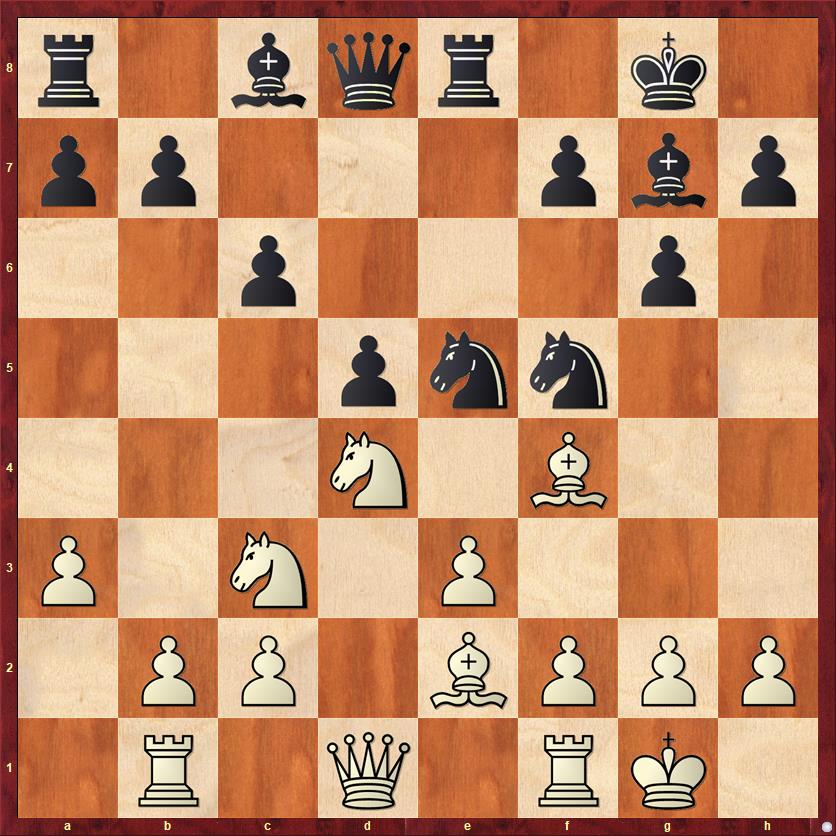
FEN: r1bqr1k1/pp3pbp/2p3p1/3pnn2/3N1B2/P1N1P3/1PP1BPPP/1R1Q1RK1 w – – 0 14
Although White has played rather unambitious chess so far, she hasn’t made any real mistakes. But after her next move, the position starts leaning in Black’s favor.
14. Nxf5? …
One thing that Mike Splane emphasized is thinking carefully about your trades. On the surface of it, this is a knight for a knight, an even trade. But there are almost no purely even trades in chess. Whom does this trade benefit, really? I think it clearly helps Black. Before this move I was struggling to figure out where to put my queen bishop. Do I put it on d7, where it has no activity and just gets in the queen’s way? Do I put it on e6, allowing my opponent to trade a knight for a bishop? Nguyen’s move solves the biggest problem in my position.
14. … Bxf5 15. Qd2 Qe7 16. Rfd1 Rad8 17. h3 h5 18. Bf1 Rd7
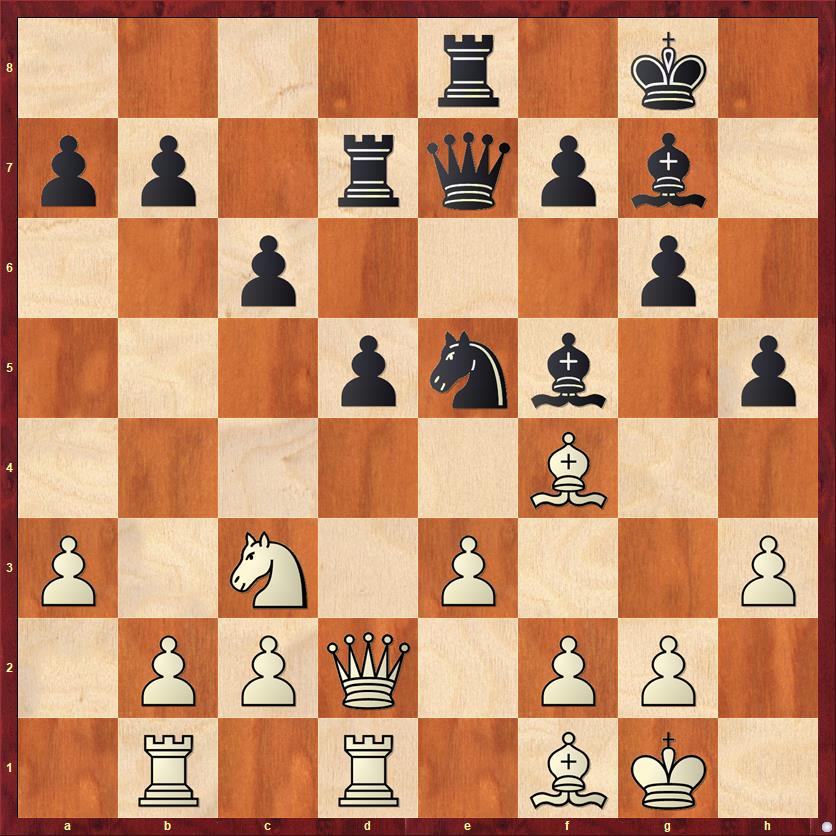
FEN: 4r1k1/pp1rqpb1/2p3p1/3pnb1p/5B2/P1N1P2P/1PPQ1PP1/1R1R1BK1 w – – 0 19
On my last move I could have put the question to White’s bishop with 18. … g5, but I didn’t want to weaken my pawn structure. So instead I played a Mike Splane-like “do-nothing” move with 18. … Rd7. And it worked perfectly! My opponent played exactly the move I was hoping for, and I didn’t even have to play a weakening move. Once again, the unforced piece trades were what got her into trouble in this game.
19. Bxe5? …
In my previous post I wrote that White’s position “goes from bad to critical.” That may be an overstatement, but it shows how optimistic I felt about Black’s position after this move.
19. … Bxe5 20. Ne2 Bc7 21. Nd4 …
If White had all the time in the world, this idea would have been a good one. But White’s kingside is woefully short of defenders.
21. … Qe5?
Right idea, but 21. … Qd6 would have been better, in order to avoid the defense 22. Nf3 (which would be met with 22. … Be4, winning).
22. g3? …
Missing her chance. After 22. Nf3 Qd6 or 22. … Qf6 23. Qd4 Qd6, my queen has taken two or three moves to get to the same place she could have gone to in one move.
22. … Be4 23. h4 …
Trying to stop the avalanche, but it’s too late.
23. … g5!
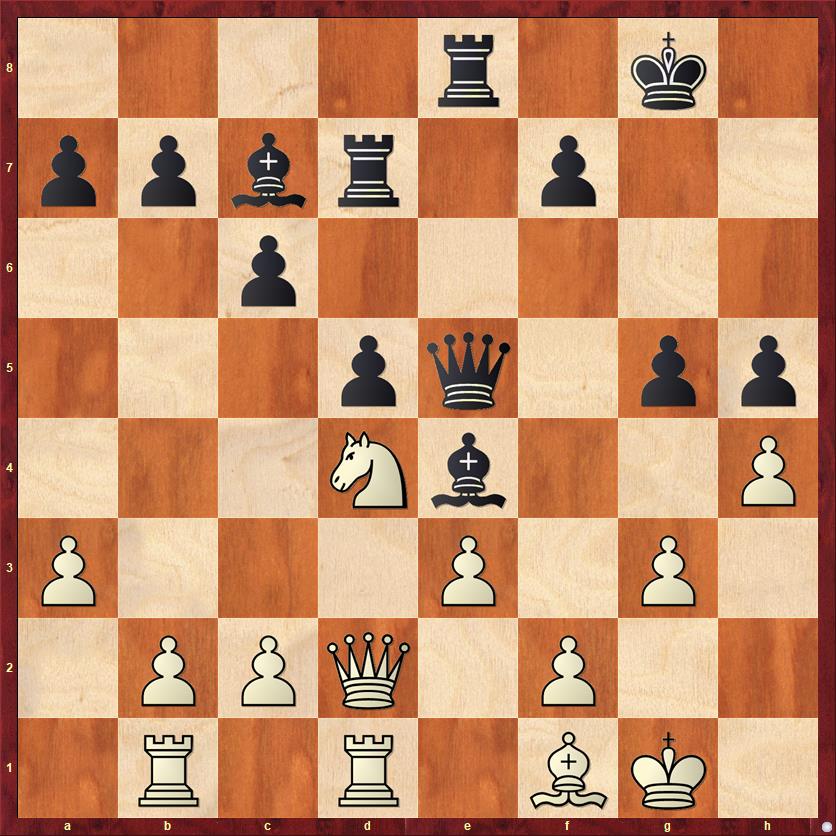
FEN: 4r1k1/pp1rqpb1/2p3p1/3pnb1p/5B2/P1N1P2P/1PPQ1PP1/1R1R1BK1 w – – 0 19
No hesitations any more! I’m not worried about weaknesses because White’s king position is the biggest weakness of all.
24. hg …
The computer suggests 24. f4, but I think this is the sort of position only a computer could defend. White has so many weaknesses, and they’re all on dark squares, and he doesn’t have a dark-squared bishop. It seems to me like a recipe for disaster.
24. … Qxg5 25. Bh3 Rd6 26. Qe2 Rf6
Now my top priority is keeping the knight out of f3, its best defensive square.
27. Bg2 …
Also fighting for control over f3, of course.
27. … h4!
The inevitable breakthrough. I was really expecting the game to be over pretty soon, and so one has to ask what Black did wrong over the next few moves.
When I wrote about this game last time, I was very surprised to see that Rybka wanted Black to play 27. … Bxg3!? However, this time I am glad to report that the computer has come to its senses, perhaps because I am using Fritz instead of Rybka. It is true that 27. … Bxg3 wins, but it’s extremely complicated and demands ultra-precise analysis. There is absolutely no sense in playing a sacrifice like this yet, when I have a move like 27. … h4 that is simple and powerful and thematic. I’m reminded of another thing that Mike Splane used to say, which is that he liked to sac his opponent’s pieces rather than his own.
So this time we’ll skip all that analysis of 27. … Bxg3. You can read about it in my previous post if you want.
28. g4 Bxg2 29. Kxg2 h3+!
It took me a while to see this shot, but it’s one of the main points behind 27. … h4. If White takes, he gets mated: 30. Kxh3 Qh6+ 31. Kg2 Qh2+ 32. Kf1 Qh1 mate. At this point we start seeing an important theme: Black would actually prefer not to have this h-pawn, because he could get at the White king much easier without it. This is the idea behind one of Mike’s most original concepts: the “traitor pawn.”
30. Kg1 Re4 31. Kh1! …
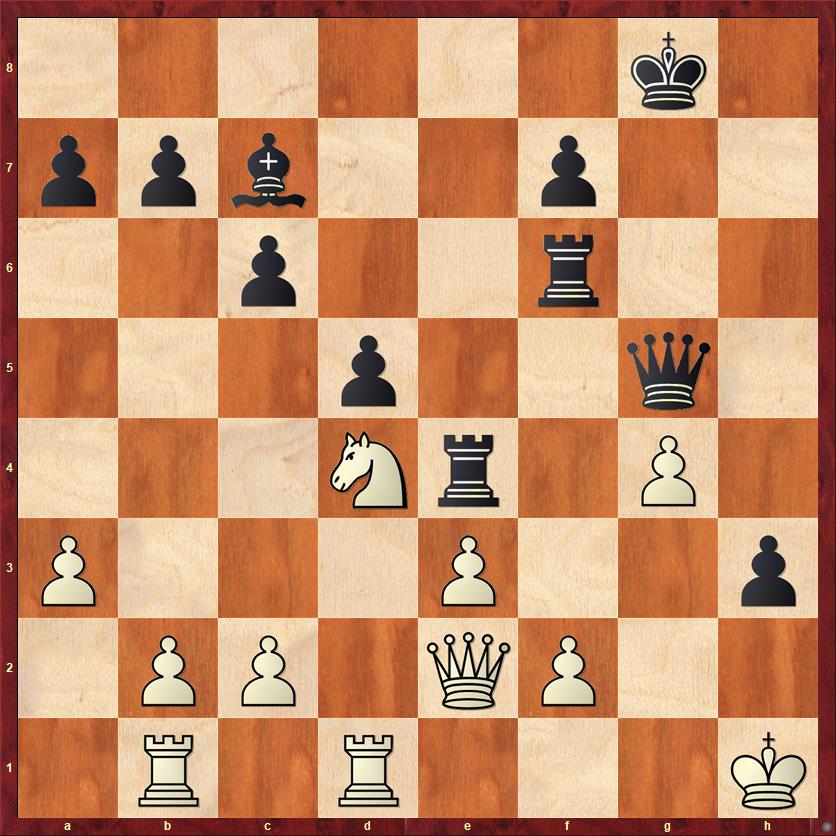
FEN: 6k1/ppb2p2/2p2r2/3p2q1/3Nr1P1/P3P2p/1PP1QP2/1R1R3K b – – 0 31
Clever and creative defense by my young opponent. She played 30. Kg1 so that she would be able to reply to 30. … Qe5 with 31. Nf3! Notice that the exchange sac 31. … Rxf3 would not work because there is no mate after 32. Qxf3 Qh2+ 33. Kf1 etc. When she followed this up with 31. Kh1 it really threw me for a loop. I was stunned to see that after the planned 31. … Rxg4? White forces a queen trade in an unusual way with 32. Qxg4! Qxg4 33. Rg1. Black is still better, but all of a sudden the game is not so easy to win.
One of the toughest things to deal with in chess is a position where you are in time trouble and something happens that you weren’t expecting. All of a sudden you have to regroup and figure out what’s going on, and you don’t have enough time to do it. That partly explains my next move. I think that the paramount consideration, for me, was that the move Rg1, creating a skewer along the g-file, had messed up my plans. Therefore I decided to prevent the move Rg1.
31. … h2?
This was the move that Mike Splane considered to be my big mistake, a move that I should have realized was wrong without even doing any analysis. It’s why he still called this “the game where you played … h2.”
The argument is this. We’ve already seen that on h3, this pawn has some traitor-ish tendencies. But once it moves to h2, it truly becomes a traitor pawn. Previously, I had checkmate threats on g2 or on h2. With the pawn on h2, all of those checkmate threats are gone. In essence, Mike said, I have committed myself to winning in the endgame. That is a big concession, because after move 27, it really looked as if I was going to blow White away in the middlegame.
So without even doing any analysis, we can conclude that … h2 is unlikely to be the right move. What should we do instead? There are two excellent options. One is 31. … Kf8! This addresses the same issue that … h2 did: the skewer on the g-file. But it does it a different way, by removing the king from that file. The first point is that now Black is threatening 32. … Rxg4 for real. The second point is that if White plays 32. Rg1 to defend that threat, now 32. … Qe5! is decisive, because it not only threatens checkmate, it threatens the knight on d4 that is no longer defended by the rook. Game over.
A different and also extremely effective move for White is 31. … Qe5! The logic is simple. If White had played 30. Kh1 right away, my answer would surely have been 30. … Qe5. Has the interpolation of 30. Kg1 and 30. … Re4 really changed anything? No! After 31. … Qe5! 32. Nf3 is still not possible because of 32. … Rxf3. If White plays 32. f4 instead, then Black simply has to retreat with 32. … Qe8, and White has too many weaknesses to defend: e3, f4, d4, and of course the king on h1 that is surrounded by open air.
Let me finally say that besides the concept of traitor pawns, this position also illustrates the importance of the Mike Splane Question: How am I going to win this game? After move 27, my answer was that I was going to push my pawn to h3 and checkmate White on g2 or h2 or h1. Either 31. … Kf8! or 31. … Qe5! would have kept those options alive. But after 31. … h2? I have sabotaged my own winning plan and now I have to figure out a new plan, with not much time remaining on my clock.
The game now enters a rather chaotic phase, which I was actually a little bit lucky to survive.
32. f4! Bxf4
I played this move reflexively, not realizing that it was a true piece sacrifice.
33. ef …
Oof! Two surprises in a row. I thought this pawn was pinned. Fortunately, this time I collected my wits and realized that I still had a ton of compensation for the piece.
33. … Qxf4
A horrific catastrophe would be 33. … Rxe2?? 34. fg when Black is a piece down and has two rooks hanging.
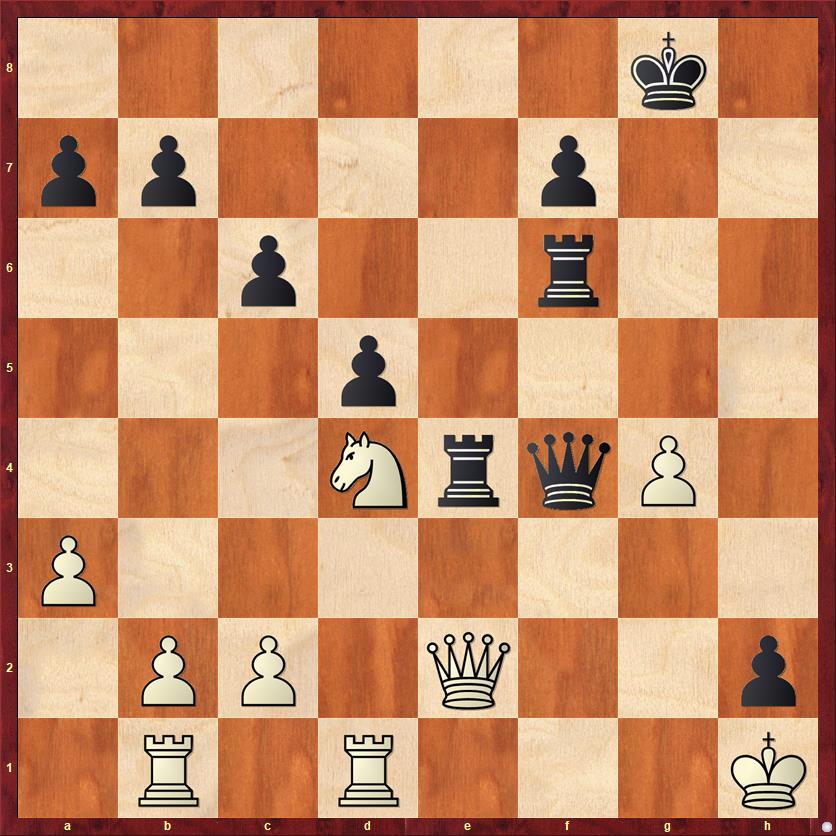
FEN: 6k1/pp3p2/2p2r2/3p4/3NrqP1/P7/1PP1Q2p/1R1R3K w – – 0 34
Although I’m a piece down, White has no time to rescue the knight because too many things are hanging. 34. Qd2 would be met by 34. … Rxd4! 35. Qxd4 Qf3+ and Black succeeds in compelling White to take the “traitor pawn.” Once again, mate follows quickly: 35. Kxh2 Rh6+ 36. Kg1 Rh1 mate.
Instead, White keeps playing for complications.
34. Rf1 Qe5 35. Nxc6 …
White still does not have enough time to save the knight (35. Nf3 Rxe2 36. Nxe5 Rxf1+ 37. Rxf1 Rxe5) so she decides to get as much material for it as she can and mess up my queenside pawns in the process.
35. … bc 36. Qa6 Re2
Unfortunately, after this move her queen has to hustle back and defend. Looks as if Black does have a few checkmate threats after all.
37. Qd3 Re3?
In spite of everything I wrote above about my 31st move, this move also has to take some of the blame for my not winning this game in the middlegame. The simple move 37. … Ref2 is very strong. One threat is 38. Rbe1 Rxf1+ 39. Rxf1 Qe4+!, and Black wins a rook after either 40. Kxh2 Qxd3 41. cd Rxf1 or 40. Qxe4 Rxf1+ 41. Kg2 de. This last line is especially nice because it’s the “traitor pawn” that wins the game after 42. Kxf1 h1Q+. Another possibility after 37. … Ref2 is 38. Rxf2 Rxf2, when White is utterly paralyzed. Black’s biggest threat is to play … d4 followed by … Qd5+ and mate.
However, practical considerations took over here. In time pressure I was thrilled to have the opportunity to repeat the position a couple of times and get to the time control at move 40, after which I would be able to take my time and figure out how to win.
38. Qd2 …
Notice that 38. Qxe3 doesn’t work because 38. … Qxe3 39. Rxf6 Qe4+ 40. Kxh2 Qe5+ wins one of the rooks.
38. … Re2 39. Qd3 Re3 40. Qd2 Qe4+ 41. Qg2 …
Time control reached. As in so many of my games, I played the first 30 moves very well, staggered through the next 10 moves in time pressure, but now I have my feet on solid ground again. My attack is basically over, but I still thought that Black should be clearly winning, with a two-pawn lead.
41. … Qxg2+ 42. Kxg2 Re2+ 43. Kh1 Rxf1+ 44. Rxf1 Rxc2 45. b4 Kg7 46. Rd1 …
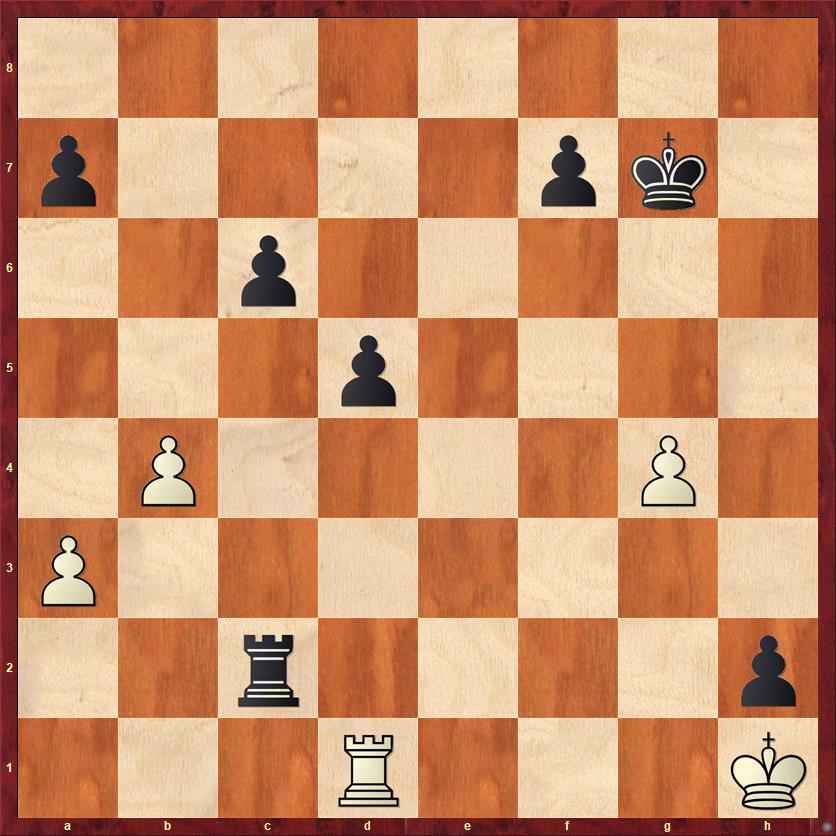
FEN: 8/p4pk1/2p5/3p4/1P4P1/P7/2r4p/3R3K b – – 0 46
Now we come to my favorite move of the game. Of course, Black is two pawns ahead. But how do we translate this advantage into a concrete winning plan?
Let’s start with White’s threat. White would obviously like to play 47. b5, blowing up Black’s pawn structure. 46. … a6 only delays it but doesn’t stop it after 47. a4, reiterating the threat. The worst-case scenario for Black would be for all the queenside pawns to get traded. Even if Black then wins the g-pawn, the endgame of R+f+h versus R (always hard even in the best of times) would here be an easy draw for White because of stalemate possibilities. The traitor pawn at h2 strikes again!
Is there any way to shut down 47. b5? Well, yes, the possibility of 46. … Rb2 comes to mind. It’s a beautiful place for the rook, paralyzing both of White’s queenside pawns. But it seems to be out of the question because White’s rook can become active and win the c-pawn after 47. Rc1.
But then I asked myself: Wait a minute, is that really so bad? Sure, White can win a pawn. In fact, I can give him another pawn. But what I get for those pawns is time — the most important thing in a rook-and-pawn endgame. Rook-and-pawn endgames are all about dynamic advantages, queening your pawn before your opponent queens his. My two-pawn lead is a static advantage. All I’m doing is trading a static advantage that is of no use to me for a dynamic advantage that wins the game.
You can also think about this position in terms of the Mike Splane Question. How is Black going to win the game? Obviously, the answer is that Black will win by promoting the d-pawn. So we should do everything we can to achieve that goal, and anything that doesn’t lead to it (such as defending the c-pawn or the a-pawn) is irrelevant.
46. … Rb2!
The computer will tell you that Black has lots of other winning moves. But I will tell you that there are no other winning moves as beautiful as this one. Watch!
47. Rc1 Kf6 48. Rxc6+ Ke5 49. Rc7 f6
While I was shedding pawns, I didn’t want to give up my f-pawn because it’s conceivable that White’s g-pawn could become a threat. The f-pawn also provides useful cover from rook checks.
50. Rxa7 Kf4 51. Rc7 d4
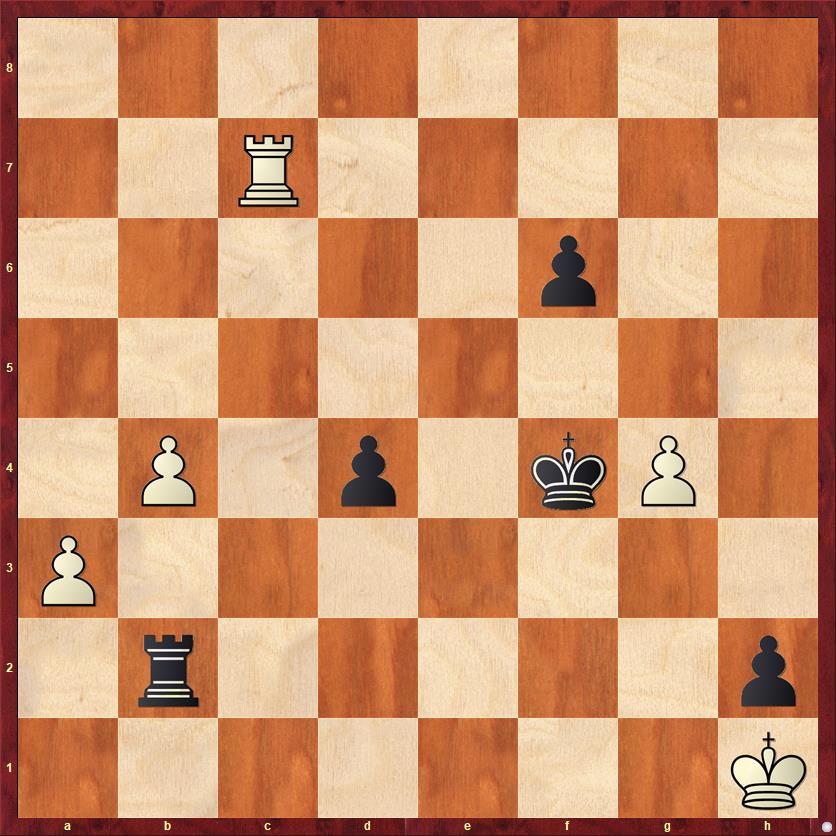
FEN: 8/2R5/5p2/8/1P1p1kP1/P7/1r5p/7K w – – 0 52
I love this position! It’s one of those rare positions (a little bit like the final position in my previous post) where every piece has an important function. My pawn on h2 keeps White’s king locked up in the corner. My rook defends the h-pawn and prepares to play a back-rank mate. My king prepares to go to g3, defending the flight squares so that … Rb1+ will be mate. My pawn at d4 provides cover from checks on the third and fourth ranks. My pawn at f6 provides cover from checks on the f-file. And let’s talk about that White pawn on g4. In the long and infamous line of traitor pawns, it is one of the worst traitor pawns of all! Ordinarily, my threat of … Kg3 would be easily defended by Rg7+, but White’s g-pawn is in the way.
To stop the back-rank checkmate, White is forced to retreat her rook to the first rank. After that, the endgame is simple. By the way, this ending illustrates one of my favorite themes: the use of checkmate threats in the endgame. Mating attacks are rare in the endgame, because there is too little material. However, mating threats are surprisingly common, and they can be used to force your opponent to make concessions — as in this game, where they force White’s rook back into passivity. It’s nice that my pawn on h2, the alleged traitor pawn, actually plays a key role in setting up that mate threat.
52. Rc1 d3 53. b5 Rxb5 54. Kxh2 …
The former “traitor pawn” dies a hero.
54. … d2 55. Rf1+ Ke3 56. Kg2 Rg5 57. Rf3+ Ke2 58. Rf2+ Kd3 59. Rf1 Kc2 60. White resigns
After the game was over, Michael Feinstein — my opponent’s coach! — came over and told me, “Congratulations! You played that endgame like a master.”
Lessons:
- Chess isn’t checkers! You don’t have to trade pieces just because you can. Ask yourself, before an “even trade,” which player it really benefits the most.
- Very often, a far-advanced pawn actually gets in the way of your attack more than it helps. A pawn that you would rather not have is called a “traitor pawn.”
- Don’t rush! A move that keeps alive the possibility of winning in either the endgame or the middlegame is usually preferable to a move that commits to winning only in the endgame.
- In rook endgames, dynamic advantages are often more important than material advantages.
- In rook endgames, it’s a big help if you can tie the opponent’s rook down to passive defense.
- In complex (rook, queen, or multi-piece) endgames, checkmate is often an important “secret weapon.” While mating attacks are uncommon, mating threats can be used to extract concessions from your opponent.



{ 1 comment… read it below or add one }
Your last point reminds me of a game by the grand old man of Northwest chess, LM Viktors Pupols. At a tournament a few years ago, we looked at his position and saw an even material endgame with one pair of rooks and bishops of opposite colors. A draw, naturally. An hour later he came into the skittles room and we said, “Draw?” He shook his head. “You won that? How?”
He set the position up, and it became apparent he had checkmated his opponent in the middle of the board with rook, bishop, and a clutch of pawns!